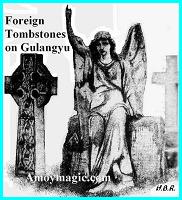 Bill Brown ... Xiamen University
Bill Brown ... Xiamen UniversityMs. Jean Walton, Secretary of the New Jersey Postal History Society, wanted someone to check out some tombstones in the Gulangyu Foreign Cemtery (also called the Amoy Foreign Cemetery). Some of the Gulangyu Foreign Cemetery epitaphs dated to the 1700s). But that won't be easy because the Chinese buried the cemetery, and over top of it built the Xiamen Music Hall. Here's the story:
Some bad news about the Kulangsu (Koolangsu, Kulangsoo) Foreigners' Cemetery. All foreigners, except for Japanese, w
 ere b
ere b uried in the foreigners' cemetery on the slopes of Huangyan road, but in the late 1957 when Britain invaded Egypt, the "masses rose up against the British imperialists who were trying to revive the empire upon which the sun never set and buried the cemetery." (Or that's what the Chinese history books say).
uried in the foreigners' cemetery on the slopes of Huangyan road, but in the late 1957 when Britain invaded Egypt, the "masses rose up against the British imperialists who were trying to revive the empire upon which the sun never set and buried the cemetery." (Or that's what the Chinese history books say).Perhaps burying the cemetery in which foreigners' was buried was a way of ensuring the twice-buried foreign devils stayed buried! (I've heard of burying the hatchet but burying the cemetery to boot goes a bit far).
In 1978, the government built the Xiamen Music Hall on the site of the buried cemetery. At least the dearly departed foreign devils can now enjoy some good Western and Chinese classical music as it is played above them in the 3 Million Yuan oval concert hall (begun in 1984 and finished in 1987).
There are now no foreign tombstones, but the Chinese cemetery is fascinating (on the West of Gulangyu Islet--near the 7th Day Adventist Building).

The Foreign cemetery had graves of foreigners from the 1700s to the 1900s, including members of the Amoy Mission such as David Abeel and Elihu Doty, etc.
See: Gulangyu Foreign Cemetery Epitaphs
Related Page: The Fuh-chau Cemetery (also written Fuchau, Foochow, etc.).
www.amoymagic.com


No comments:
Post a Comment